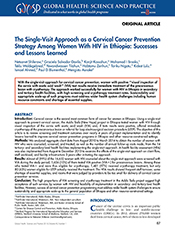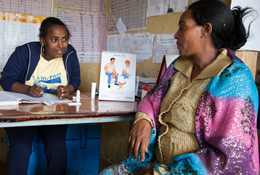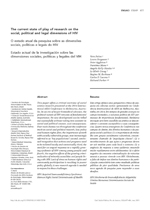Cervical Cancer Prevention
Through a five‐year Centers for Disease Control-supported project, Pathfinder has developed an innovative approach to increasing access to and use of cervical cancer prevention services for women living with HIV in Ethiopia. Pathfinder has introduced the single-visit approach that allows providers to detect precancerous lesions and offer treatment on the same day.
Pathfinder recently received one year of additional funding from the CDC for this work.
The initiative leads to improved care for a very treatable condition, cervical pre-cancer, if diagnosed early. Working with the Ministry of Health, Pathfinder is building national capacity to support comprehensive facility-based services; promoting community education and awareness of cervical cancer; and establishing strategic alliances and partnerships to expand the use of these services. Stanford University’s Program for International Reproductive Education and Services, the project’s international technical partner, provides technical knowledge, evidence-based training materials, and extensive experience with cryotherapy in low-resource settings.
The success of this intervention led Ethiopia’s Ministry of Health to expand this project from 14 pilot facilities to 118 hospitals.
Since it began in 2009, the project has established services at all 14 planned facilities, including five Centers of Excellence plus nine other facilities, all of which are providing single-visit approach to cervical cancer prevention services.
So far, the project has provided visual inspection with acetic acid services to more than 20,000 women, which well exceeds the life-of-project target of 5,000. In fact, most of the hospitals that initiated services early in the project have nearly exhausted targeted clients in their catchment areas, and there is great interest in expanding services to the general population who are in need of services.
SPREAD THE WORD Share this graphic on Twitter or Facebook!

Related Publications

The Single-Visit Approach as a Cervical Cancer Prevention Strategy Among Women With HIV in Ethiopia: Successes and Lessons Learned
With the single-visit approach for cervical cancer prevention, women with positive “visual inspection of the cervix with acetic acid wash” test results receive immediate treatment of the precancerous lesion with cryotherapy. The approach worked successfully for women with HIV in Ethiopia in secondary and tertiary health facilities, with high screening and cryotherapy treatment rates.
Beyond AIDS - Supporting Ethiopian Women to Access Cervical Cancer Screening
This brief provides a concise overview of recent activities of the Addis Tesfa cervical cancer prevention project in Ethiopia. Addis Tesfa brings highly effective, yet very simple, cervical cancer prevention methods to women living with HIV.
Cervical Cancer Prevention: The Single-Visit Approach Quality Management Toolkit
This toolkit contains 17 tools designed to help health care providers and program planners set up, ensure the quality of, and monitor single-visit approach (also known as “see-and-treat”) services for the prevention of cervical cancer.
LEEP Clinical Standards of Practice
his manual guides trained health care providers through the LEEP procedure to remove precancerous cervical lesions that cannot be treated with cryotherapy in order to prevent cervical cancer.
Related Projects

Ethiopia Community Prevention of Mother-to-Child Transmission Project
PAST PROJECT: Pathfinder increased access to and demand for prevention of mother-to-child transmission services through the creation of a community-based, integrated model in cooperation with the Ministry of Health.

Ethiopian Women's and Girl's Empowerment through Education and Reproductive Health Knowledge and Access to Services
PAST PROJECT: With funding from the Packard Foundation, Pathfinder worked with local partners to improve the education, health, rights, and social status of adolescent girls and women.

Evidence to Action for Strengthened Family Planning and Reproductive Health Services for Women and Girls (E2A)
The Evidence to Action Project (E2A) is USAID’s global flagship for strengthening family planning and reproductive health service delivery.
RELATED NEWS

The Current State of Play of Research on the Social, Political and Legal Dimensions of HIV
This paper offers a critical overview of social science research presented at the 2014 International AIDS Conference in Melbourne, Australia.
What the US can learn from Ethiopia about birth control
What's more, women in Ethiopia are having fewer children (the fertility rate fell from an average of 6.5 children per woman in 2000 to 4.6 currently), maternal deaths are in decline, and more women are staying in school longer. Plus, more women are opting for long-acting reversible contraceptives (LARCs) instead of more traditional short-term methods like birth control pills or condoms.








